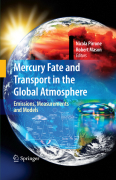
Mercury fate and transport in the global atmosphere: emissions, measurements and models
Pirrone, Nicola
Mason, Robert
Mercury, primarily because of its existence and bioaccumulation as methylmercury in aquatic organisms, is a concern for the health of higher trophic level organisms, or to their consumers. This is the major factor driving current research in mercury globally and in environmental regulation, and is the driver for the current UNEP Global Partnership for Mercury Transport and Fate Research(UNEP F;T) initiative. The overall focus of the UNEP F;T report is to assess the relative importance of different processes/mechanisms affecting the transfer of mercury (Hg) from emission sources to aquatic and terrestrial receptors and provide possible source-receptor relationships. This transfer occurs through atmospheric transport, chemical transformations and subsequent deposition, and involves the intermittent recycling between reservoirs that occurs prior to ultimate removal of Hg from the atmosphere. Understanding the sources, the global Hg transport and fate, and the impact of human activity on the biosphere, requires improved knowledge of Hg movement and transformation in the atmosphere. An improved understanding of Hg emission sources, fate and transport is important if there is to be a focused and concerted effort to set priorities and goals for Hg emission management and reduction at the national, regional andglobal levels; and to develop and implement such policies and strategies. To achieve this, a series of coordinated scientific endeavors focused on the estimation of sources, measurement and validation of concentrations and processes,and modeling, coupled with interpretation of the results within a policy framework, is likely to be required. INDICE: Global mercury emissions to the atmosphere from natural and anthropogenic sources.- Mercury emissions from coal combustion in China.- Mercury emissions from industrial sources in China.- Mercury emissions from industrial sources in India - Mercury emissions from point sources in South Africa.- Worldemissions of mercury from artisanal and small scale gold mining- Mercury emissions from natural processes…- Mercury emissions from global biomass burning- Spatial coverage and temporal trends of land-based atmospheric mercury measurements in the northern and southern hemispheres.- Spatial coverage and temporaltrends of atmospheric mercury measurements in the polar regions.- Spatial coverage and temporal trends of over-water, surface, air-surface exchange and deep sea water mercury measurements.- Monitoring and modeling projects for fate of mercury species in Japan.- The need for coordinated global mercury monitoring network- Our current understanding of major chemical and physical processes affecting mercury dynamics- Mercury chemical transformation in the gas, aqueous and heterogeneous phases- Importance of a global scale approach to using regional models- Global mercury modeling at Environment Canada.- The GEOS-Chem model.- The ECHMERIT model.- The EMEP/MSC-E mercury modeling system.- The AER/EPRI Global Chemical Transport Model for Mercury (CTM-Hg).
- ISBN: 978-0-387-93957-5
- Editorial: Springer
- Encuadernacion: Cartoné
- Páginas: 644
- Fecha Publicación: 17/06/2009
- Nº Volúmenes: 1
- Idioma: Inglés
